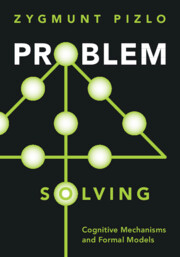Book contents
- Problem Solving
- Problem Solving
- Copyright page
- Dedication
- Contents
- Figures
- Tables
- Preface
- Chapter 1 Problem Solving
- Chapter 2 Animal Problem Solving
- Chapter 3 Modern Research on the Human Ability to Solve Problems that Have Large Search Spaces
- Chapter 4 The Exponential Pyramid Representation that Compensates for Exponentially Large Problem Spaces
- Chapter 5 Heuristic Function, Distance, and Direction in Solving Problems
- Chapter 6 Insight and Creative Thinking
- Chapter 7 Inference in Perception
- Chapter 8 Cognitive Inferences, Mental Representations
- Chapter 9 Theory of Mind
- Chapter 10 Solving Problems in Physics and Mathematics
- Chapter 11 Summary and Conclusions
- References
- Index
Chapter 2 - Animal Problem Solving
Innovative Use of Tools
Published online by Cambridge University Press: 23 June 2022
- Problem Solving
- Problem Solving
- Copyright page
- Dedication
- Contents
- Figures
- Tables
- Preface
- Chapter 1 Problem Solving
- Chapter 2 Animal Problem Solving
- Chapter 3 Modern Research on the Human Ability to Solve Problems that Have Large Search Spaces
- Chapter 4 The Exponential Pyramid Representation that Compensates for Exponentially Large Problem Spaces
- Chapter 5 Heuristic Function, Distance, and Direction in Solving Problems
- Chapter 6 Insight and Creative Thinking
- Chapter 7 Inference in Perception
- Chapter 8 Cognitive Inferences, Mental Representations
- Chapter 9 Theory of Mind
- Chapter 10 Solving Problems in Physics and Mathematics
- Chapter 11 Summary and Conclusions
- References
- Index
Summary
This chapter begins with a review of insight problem solving done by infrahuman animals. This work started when Wolfgang Köhler performed his informal studies of chimpanzees over 100 years ago on Tenerife. Are chimps smart because they have large brains? The size of its brain seems to be only weakly related to an animal's intelligence. What seem to be more important are the mental mechanisms that an animal uses, including, or perhaps primarily, the animal’s ability to visualize physical and geometrical transformations, such as the ability to realize that one's reflection in a mirror is a 3D image of one’s body. This ability was tested extensively with both chimpanzees and monkeys. A more elaborate experimental design was subsequently used to test the chimps’ ability to perform visual-motor coordinations with a transformed camera image. Next, the problem-solving ability of crows, parrots, and hyenas is described, and this chapter ends with the presentation of results of experiments performed by chimps and monkeys on solving the traveling salesman problem (TSP). The TSP is one of the best-studied problems both in cognitive psychology and in computer science. Human performance on the TSP is discussed in detail in the following two chapters. You will discover how sophisticated, but naïve, human subjects are when confronted with solving the TSP.
Information
- Type
- Chapter
- Information
- Problem SolvingCognitive Mechanisms and Formal Models, pp. 14 - 33Publisher: Cambridge University PressPrint publication year: 2022
